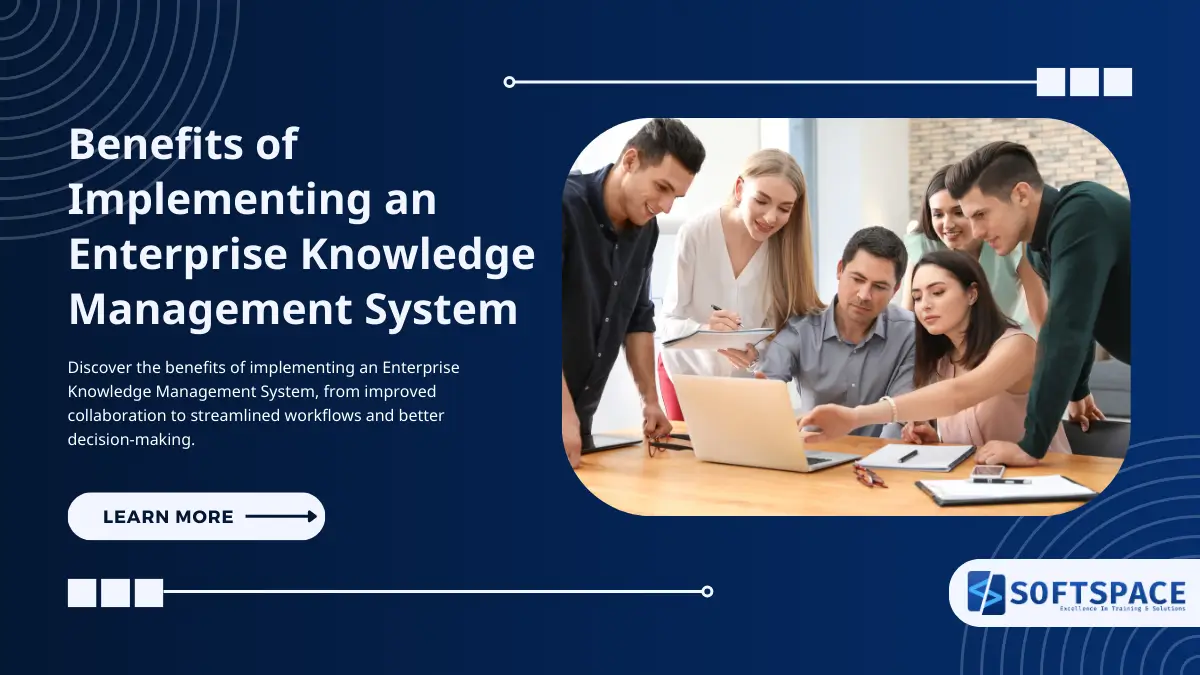In modern business’s fast-paced world, managing corporate knowledge has become crucial. An enterprise knowledge management system ensures that a company’s collective knowledge is catalogued, accessible, and up-to-date, enabling employees to make better decisions and excel at their work. Such systems are not merely a repository for information but a dynamic tool that enhances the entire business ecosystem. Keep reading to discover the benefits an enterprise knowledge management system can bring your business.
So, let us understand the Benefits of Implementing an Enterprise Knowledge Management System in detail.
Benefits of Implementing an Enterprise Knowledge Management System
Enhancing Collaboration and Information Sharing

Collaboration is the keystone of innovation and productivity within any enterprise. A knowledge management system fosters a collaborative environment by dissolving the barriers to information sharing. It enables teams working from different locations or time zones to connect and contribute to a shared pool of knowledge, breaking down geographical and hierarchical boundaries.
Within such an ecosystem, onboarding new employees is streamlined, as they can access the organization’s collective knowledge from their first day. Meanwhile, experienced employees are empowered to share insights and best practices, becoming active participants in the company’s knowledge-sharing culture.
Inter-departmental communication is another beneficiary of this enhanced collaboration. For example, marketing can quickly draw on the insights gathered by sales to create more targeted campaigns. At the same time, research and development can use customer feedback collected by customer service to improve product design.
This synergy optimizes workflows and nurtures a more connected workforce. The transparency and accessibility instilled by a robust knowledge management system can build a culture of trust where employees are encouraged to contribute and leverage shared knowledge for collective success.
Improving Organizational Efficiency and Productivity

Efficiency and productivity are at the heart of any successful enterprise, and an efficient knowledge management system acts as a catalyst in this regard. By centralizing information, employees spend less time hunting for data and more time applying it. The rapid retrieval of information results in quicker decision-making and increased agility in business operations.
Productivity gains are also seen when employees can share their expertise and build upon each other’s work. Duplication of effort is minimized when everyone has visibility into what has already been accomplished. Project management becomes more streamlined as project-related documents and developments are accurately tracked and documented for future reference.
Moreover, the system can automate routine tasks, freeing employees’ time for higher-value work. Workflow automation tools can trigger notifications, approvals, and updates without human intervention, enhancing accuracy and reducing overhead.
The consistent and uniform access to knowledge across the enterprise ensures that quality standards are maintained. When everyone works from the same source of truth, discrepancies and errors become less frequent, thus improving overall output and service delivery.
Facilitating Decision-Making with Centralized Knowledge
In business, timely and well-informed decisions are paramount. Centralized knowledge within a knowledge management system provides a clear vantage point from which decision-makers can draw actionable insights. Data-driven decision-making replaces guesswork, relying on accurate, up-to-date information curated from various sources.
The ability to analyze trends, access market research, and review historical data informs strategies and guides future planning. When leaders have centralized knowledge, they can more effectively visualize their business’s landscape, predict consumer behaviour, and anticipate market changes.
Furthermore, risk management improves as potential issues can be spotted early on through the collective intelligence embedded within the system. This proactive approach can save companies considerable effort and resources by thwarting problems before they escalate.
An intuitive knowledge management system can also feature reporting and analytic tools that render complex data into comprehensible reports. Such capability empowers those at different levels of the organization to understand and utilize the insights derived, fostering a more inclusive decision-making process.
Overall, implementing an enterprise knowledge management system drives collaboration, improves efficiency, and supports informed decision-making across the organization. By centralizing knowledge, businesses can enhance productivity, reduce errors, and foster a culture of continuous improvement.
Advantages of Knowledge Management Systems
1. Improved Knowledge Retention
One of the biggest challenges for businesses is losing valuable knowledge when employees leave. An Enterprise Knowledge Management System (KMS) helps organisations capture and store expertise, best practices, and institutional knowledge in a structured way. By documenting important processes and insights, companies ensure that critical information remains accessible, reducing dependency on individuals and fostering long-term knowledge continuity.
2. Enhanced Collaboration and Communication
Effective collaboration is key to a company’s success, yet many organisations struggle with information silos. A KMS facilitates seamless knowledge sharing across departments and teams, allowing employees to access relevant information easily. By centralising communication and knowledge resources, organisations can improve teamwork, reduce redundancy, and ensure everyone is working with the same, up-to-date information.
3. Increased Productivity and Efficiency
Employees often spend a significant amount of time searching for the right information, which hampers productivity. A well-implemented KMS reduces this inefficiency by providing a centralised knowledge repository. With quick access to documents, guidelines, and expertise, employees can focus on their tasks instead of wasting time looking for data. This results in faster workflows, improved efficiency, and optimised resource utilisation.
4. Better Decision-Making
Making informed decisions requires access to accurate and timely information. A KMS ensures that employees and management can retrieve relevant insights, case studies, and reports when needed. By leveraging documented data and past experiences, organisations can make strategic, data-driven decisions, minimising errors and improving overall business outcomes.
5. Faster Employee Onboarding and Training
New employees often face a steep learning curve when joining an organisation. A KMS simplifies onboarding by providing structured learning resources, training materials, and company policies in a single location. This allows new hires to familiarise themselves with company processes more quickly, reducing training time and enabling them to become productive members of the team faster.
6. Improved Customer Service and Satisfaction
Customer service teams often deal with a large volume of queries, requiring quick and accurate responses. A KMS enables support agents to access relevant information, FAQs, and troubleshooting guides instantly. By improving response time and accuracy, businesses can enhance customer satisfaction, build loyalty, and ensure a better overall experience for clients.
7. Encourages Innovation and Continuous Improvement
Innovation thrives in an environment where knowledge is shared and accessible. A KMS allows employees to build on existing knowledge, share ideas, and learn from past projects. This fosters a culture of continuous improvement and innovation, helping businesses stay competitive and develop new solutions more efficiently.
8. Compliance and Risk Management
Maintaining compliance with industry regulations and internal policies is essential for avoiding legal and financial risks. A KMS helps organisations document and store critical regulatory information, ensuring employees follow standard operating procedures. By providing easy access to compliance guidelines, businesses can reduce risks, avoid penalties, and maintain a strong reputation.
Drawbacks of Implementing an Enterprise Knowledge Management System
While an Enterprise Knowledge Management System (KMS) offers numerous benefits, it also comes with certain challenges that businesses should consider before implementation.
1. High Initial Costs
Setting up a KMS requires investment in software, infrastructure, and training. Businesses may need to purchase licences, customise the system, and integrate it with existing platforms, which can be expensive, especially for small and medium-sized enterprises.
2. Resistance to Change
Employees may be reluctant to adopt a new system, especially if they are used to traditional ways of storing and sharing knowledge. Without proper training and a change management strategy, the adoption process can be slow, leading to underutilisation of the system.
3. Time-Consuming Implementation
Deploying a KMS is not an overnight process. It requires time to collect, organise, and structure knowledge in a way that is useful for employees. Additionally, maintaining and updating the system regularly can be resource-intensive.
4. Information Overload
A poorly managed KMS can lead to information overload, where employees struggle to find relevant data amid excessive documentation. Without a proper categorisation and search system, the very purpose of knowledge management can be undermined.
5. Security and Data Privacy Concerns
Storing vast amounts of sensitive business information in a centralised system raises security risks. Without proper access controls, encryption, and cybersecurity measures, organisations may face data breaches or unauthorised access to critical information.
6. Maintenance and Updates
A KMS is not a one-time setup; it requires continuous updates, monitoring, and maintenance to ensure that the information remains relevant and accurate. Failing to keep the system updated can lead to outdated or misleading information, reducing its effectiveness.
7. Dependency on Technology
If a business relies heavily on its KMS, technical failures or system downtimes can disrupt operations. Ensuring a reliable IT infrastructure and backup solutions is crucial to mitigate risks associated with system failures.
Despite these challenges, the benefits of a well-implemented KMS often outweigh the drawbacks when businesses take the right approach. Proper planning, training, and continuous improvement can help organisations maximise the value of their knowledge management initiatives.
Conclusion
Implementing an Enterprise Knowledge Management System (KMS) is a game-changer for organisations looking to streamline operations, enhance collaboration, and drive productivity. By effectively capturing, storing, and sharing knowledge, businesses can improve decision-making, boost employee efficiency, and ensure long-term knowledge retention. Additionally, a well-structured KMS enhances customer service, fosters innovation, and helps maintain compliance with industry regulations.
In today’s fast-paced business environment, leveraging a KMS is no longer optional but a necessity. Companies that prioritise knowledge management gain a competitive edge by making informed decisions, reducing inefficiencies, and fostering a culture of continuous learning and improvement. Investing in a robust KMS today can set the foundation for long-term success and sustainable growth.

13+ Yrs Experienced Career Counsellor & Skill Development Trainer | Educator | Digital & Content Strategist. Helping freshers and graduates make sound career choices through practical consultation. Guest faculty and Digital Marketing trainer working on building a skill development brand in Softspace Solutions. A passionate writer in core technical topics related to career growth.

